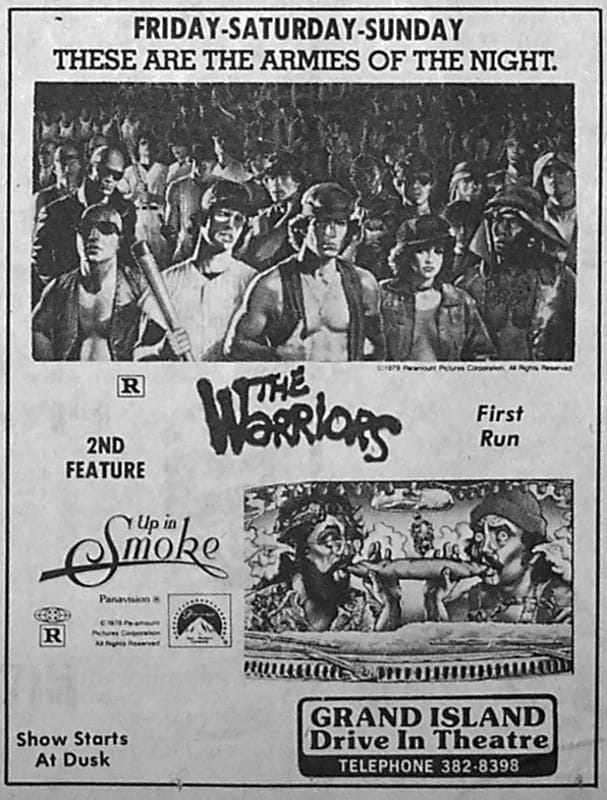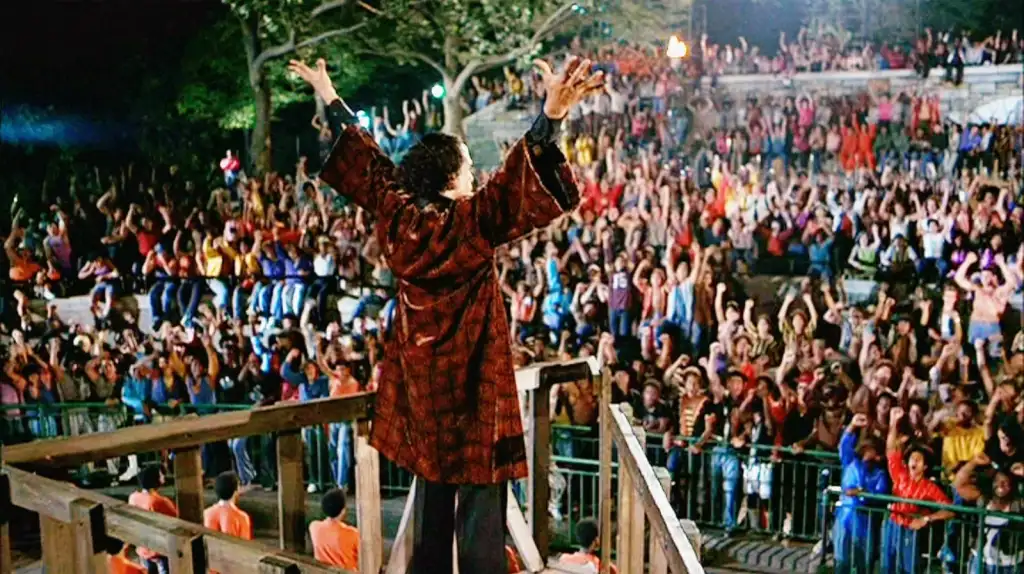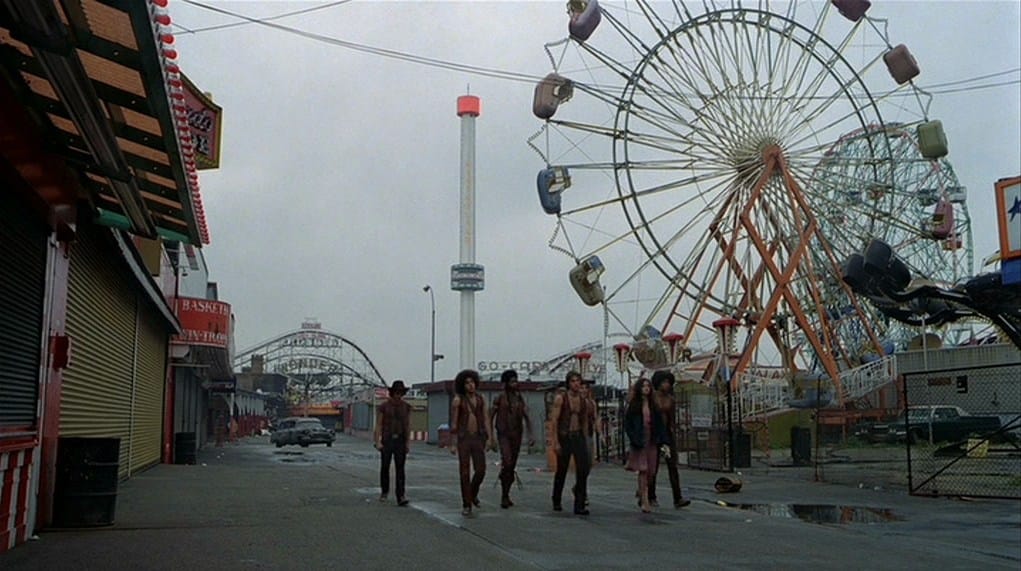I still remember renting The Warriors from the local video shop in the late 80s. The cover art alone was enough to grab your attention—those leather-clad figures emerging from the urban night. What started as a casual Friday night rental turned into a mesmerising journey through Walter Hill’s neon-soaked vision of New York City. That experience—discovering this strange, stylised world through home video—is exactly how this film found its true audience.
The Warriors didn’t just survive its brutal 1979 theatrical run. It conquered the cultural landscape through sheer force of will. This $4 million gang odyssey transformed from a violence-controversial box office concern into a mythological touchstone that continues influencing everything from hip-hop to video games 45 years later.
Rewind Zone Ratings:Nostalgia Factor: 9/10 (Pure 70s midnight movie magic)Rewatch Value: 10/10 (New details emerge every viewing)Hidden Gem Scale: 6/10 (Once hidden, now widely celebrated)

The Controversial Opening
The film opened February 9, 1979, in 670 theaters without advance screenings. It earned a respectable $3.5 million opening weekend, but within days, everything changed.
Real violence erupted at theaters across the country. Three separate fatal incidents linked to screenings led Paramount to pull all advertising. They offered theaters security funding just to keep showing it.
Critics were equally brutal:
- Roger Ebert called it “an exercise in mannerism”
- Gene Siskel dismissed it with one star
- Most reviews compared it to “silly ’60s motorcycle pictures”
But one voice stood apart. Pauline Kael of The New Yorker recognized something special:
“The Warriors is like visual rock… it has in visual terms the kind of impact that ‘Rock Around the Clock’ did behind the titles of Blackboard Jungle.”
Her prescient review would prove prophetic. The film found its true audience not in theatres, but through home video and midnight screenings.
The 1980 VHS release became the film’s salvation. Freed from theatrical controversy, The Warriors revealed its comic book-inspired artistry through repeated viewings. By the early 1980s, Michael Beck reported that midnight screenings in Paris resembled Rocky Horror-style audience participation.
The Visual Innovation
Director Walter Hill and cinematographer Andrew Laszlo created something unprecedented. A comic book brought to life through innovative night photography and bold colour choices.


Movie Stills From The Warriors (1979)
Hill envisioned every scene as a “splash panel” coming to life. He deliberately banned human spontaneity to create what he called “a ballet of stylised male violence.”
The Gang Costumes
Costume designer Bobbie Mannix scoured NYC streets to create each gang’s unique identity:
- The Warriors: Burgundy leather vests with Native American accents
- The Baseball Furies: Pinstriped uniforms and KISS-inspired face paint
- The Lizzies: All-female gang in colorful punk attire
- The Gramercy Riffs: Sophisticated street clothes with African influences
The Furies’ makeup was pulled “out of my brain,” Mannix recalled. It created one of cinema’s most haunting and surreal adversaries.
Technical Innovation Alert: The Warriors was the first film to shoot extensively on moving NYC subway trains with full Transit Authority cooperation. Hidden lighting rigs in tree branches and fake business signs illuminated the urban night.
Streets were systematically wetted for visual consistency. This created the film’s signature gleaming nocturnal aesthetic—a New York that felt both authentic and fantastical.
Hip-Hop Culture
The Warriors became nothing less than a foundational text for hip-hop culture. It influenced everything from crew-based identity to sampling aesthetics.
Wu-Tang Clan extensively sampled the film’s dialogue throughout their discography. RZA cited it as a major influence on the group’s entire mythology. The film’s concept of diverse gangs with distinct identities directly paralleled hip-hop’s emerging crew culture.
Music and Fashion Impact
- M.O.P.’s “Warriorz” literally recreated Luther’s “Warriors, come out to play” taunt
- Ice Cube and Ghostface Killah wove themes of loyalty and urban survival into their work
- The film’s influence on streetwear made Warriors burgundy vests highly collectible
- Original costume pieces now sell for $15,000 at auction
The 2005 Rockstar Games video game adaptation featured the original cast and grossed $37 million. It’s considered one of the best film-to-game adaptations ever made.
Ancient Myths and Urban Streets
What elevates The Warriors beyond simple gang exploitation is its direct foundation in Xenophon’s “Anabasis”—the 401 BC account of Greek mercenaries fighting their way home through hostile territory.
Character names like Cleon and Ajax weren’t accidental. They connected the film to classical heroic tradition while addressing contemporary urban anxieties.
Fun Fact: The night-long journey functions as a collective rite of passage, transforming neighborhood toughs into legendary figures through shared adversity.
Memorable Scenes
Luther’s bottle-clanking “Warriors, come out to play” taunt was improvised by David Patrick Kelly. It became one of cinema’s most quoted lines.
The Baseball Furies silent chase through Riverside Park exemplified the film’s comic book aesthetic. Meanwhile, Cyrus’s “Can you dig it?” speech provided a messianic vision of gang unity that hip-hop artists would quote for decades.
Three Generations of Discovery
The film’s cult status was built through distinct waves of discovery:
1980s Generation
- Discovered through VHS rentals and cable TV
- Connected with synthesiser soundtrack and comic book aesthetic
- Found it during the home video boom
1990s Generation
- Found it through hip-hop culture and midnight screenings
- Wu-Tang Clan’s extensive sampling made it required listening
- Gaming culture influence began building
2000s Generation
- Brought critical rehabilitation
- The New York Times included it in “Best 1,000 Movies Ever Made” (2003)
- Entertainment Weekly ranked it #16 on “Top 50 Greatest Cult Films”
The 2005 Director’s Cut DVD featured Walter Hill’s comic book-style freeze frames and comprehensive documentaries. It introduced the film to HD-era audiences with proper artistic context.
You Might Remember This If…
- You owned the soundtrack on cassette tape
- You tried to recreate the gang’s whistle in your neighbourhood
- Luther’s bottle-clinking gave you chills every single time
- You debated which gang had the coolest look with your friends
- Late-night cable movie discoveries were your weekend ritual
- You recognised Michael Beck years later in Xanadu and felt confused
Building the Legend Through Controversy
Paradoxically, the very controversy that nearly killed The Warriors in 1979 became part of its mystique.
The film’s association with real violence created an aura of danger. When mainstream critics dismissed it as exploitative, they inadvertently positioned it as countercultural—exactly what midnight movie audiences would champion.
International censorship enhanced its outlaw status. France initially X-rated it for “incitement to violence,” cutting 10 minutes before allowing normal release. This forbidden fruit aspect made it more appealing to young audiences seeking authentic, uncompromising cinema.
Did You Know? Unlike other cult films that gain followings through ironic appreciation, The Warriors earned its status through genuine artistic merit and thematic depth.
The cast of The Warriors took vastly different career paths after their night of urban mythology. Michael Beck went from gang leader to Xanadu roller-skating, while others left Hollywood entirely.


Michael Beek And James Remar Then and Now Comparisons
James Remar built a successful character actor career spanning decades. David Patrick Kelly became a respected theatre actor. The journeys are as diverse as the gangs themselves.
Walter Hill’s Vision
The Warriors represents peak Walter Hill filmmaking—the perfect fusion of his obsessions with male camaraderie, stylised violence, and mythological storytelling.
Hill’s other works like The Driver and The Long Riders explore similar themes, but The Warriors achieved something unique. It created a complete mythological world that audiences could inhabit and revisit endlessly.
The Legend Lives On
The Warriors’ transformation from controversial flop to beloved cult classic demonstrates how truly original art can transcend initial reception.
Through home video, midnight screenings, hip-hop culture, and generational discovery, this $4 million gang odyssey became a cultural phenomenon. It continues influencing media and inspiring new audiences 45 years later.
Lin-Manuel Miranda’s 2024 concept album adaptation proves the story’s enduring power. When a Hamilton creator finds inspiration in Walter Hill’s urban warriors, you know something special happened in 1979.
The film’s legacy isn’t just cultural impact—it’s showing that cinema could be both populist entertainment and sophisticated art.
Walter Hill’s vision of New York as a mythological landscape created a template that countless filmmakers, musicians, and storytellers continue following.
Can you dig it? Millions of fans across generations certainly can.
Want to explore more cult classics and hidden gems from cinema’s golden decades? Check out our Deep Dives collection for more fascinating film stories that deserve rediscovery.
